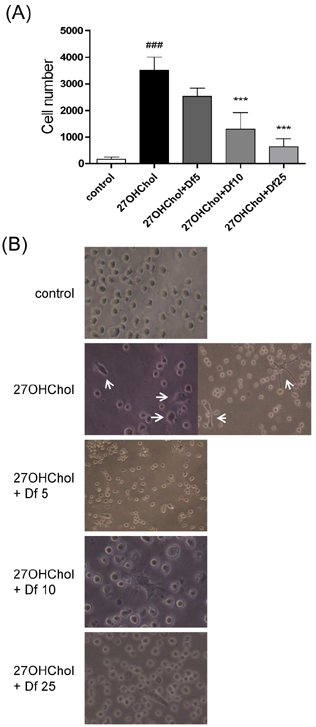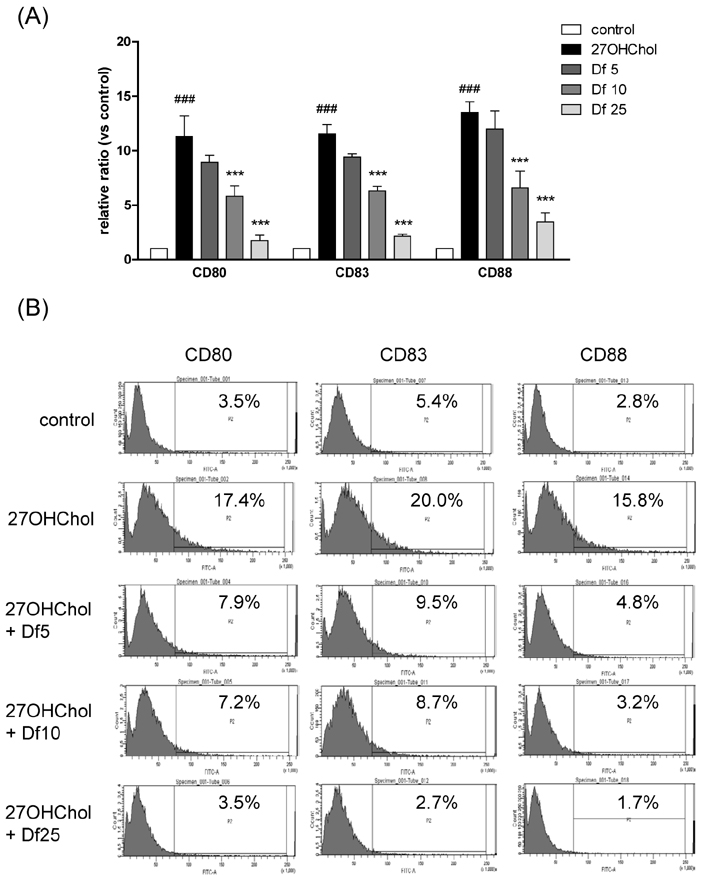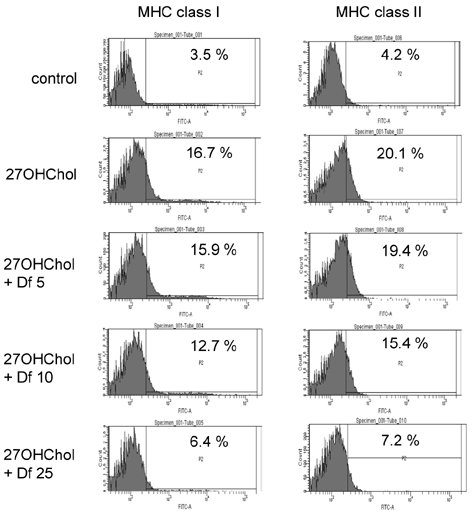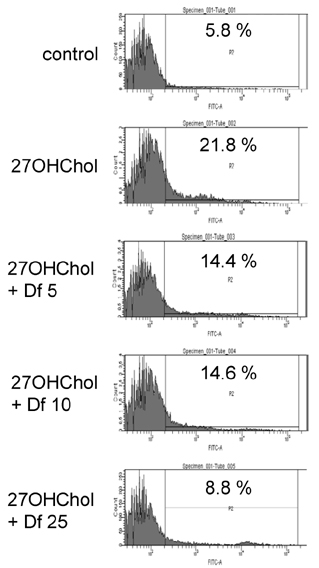Immune Netw.
2017 Jun;17(3):179-185. 10.4110/in.2017.17.3.179.
Diclofenac Inhibits 27-hydroxycholesterol-induced Differentiation of Monocytic Cells into Mature Dendritic Cells
- Affiliations
-
- 1Department of Pharmacology, Pusan National University School of Medicine, Yangsan 50612, Korea. koanhoi@pusan.ac.kr
- 2Department of Microbiology & Immunology, Pusan National University School of Medicine, Yangsan 50612, Korea.
- 3Institute of Marine BioTechnology, Pusan National University, Busan 46241, Korea.
- KMID: 2383356
- DOI: http://doi.org/10.4110/in.2017.17.3.179
Abstract
- We investigated whether diclofenac could influence the development of antigen-presenting cells in an oxygenated cholesterol-rich environment by determining its effects on the 27-hydroxycholesterol (27OHChol)-induced differentiation of monocytic cells into mature dendritic cells (mDCs). Treatment of human THP-1 monocytic cells with diclofenac antagonized the effects of 27OHChol by attenuating dendrite formation and cell attachment and promoting endocytic function. Diclofenac inhibited the transcription and surface expression of the mDC markers of CD80, CD83, and CD88, and reduced the 27OHChol-induced elevation of surface levels of MHC class I and II molecules to the basal levels in a dose-dependent manner. It also reduced the expression of CD197, a molecule involved in DC homing and migration. These results indicate that diclofenac inhibits the differentiation of monocytic cells into mDCs, thereby potentially modulating adaptive immune responses in a milieu rich in cholesterol oxidation products.
MeSH Terms
Figure
Reference
-
1. Steinman RM. The dendritic cell system and its role in immunogenicity. Annu Rev Immunol. 1991; 9:271–296.
Article2. Zhou LJ, Tedder TF. CD14+ blood monocytes can differentiate into functionally mature CD83+ dendritic cells. Proc Natl Acad Sci U. S. A. 1996; 93:2588–2592.
Article3. Sallusto F, Lanzavecchia A. Efficient presentation of soluble antigen by cultured human dendritic cells is maintained by granulocyte/macrophage colony-stimulating factor plus interleukin 4 and downregulated by tumor necrosis factor alpha. J Exp Med. 1994; 179:1109–1118.
Article4. Lyakh LA, Koski GK, Telford W, Gress RE, Cohen PA, Rice NR. Bacterial lipopolysaccharide, TNF-alpha, and calcium ionophore under serum-free conditions promote rapid dendritic cell-like differentiation in CD14+ monocytes through distinct pathways that activate NK-kappa B. J Immunol. 2000; 165:3647–3655.
Article5. Berges C, Naujokat C, Tinapp S, Wieczorek H, Hoh A, Sadeghi M, Opelz G, Daniel V. A cell line model for the differentiation of human dendritic cells. Biochem Biophys Res Commun. 2005; 333:896–907.
Article6. Son Y, Kim SM, Lee SA, Eo SK, Kim K. Oxysterols induce transition of monocytic cells to phenotypically mature dendritic cell-like cells. Biochem Biophys Res Commun. 2013; 438:161–168.
Article7. Bobryshev YV. Dendritic cells and their role in atherogenesis. Lab Invest. 2010; 90:970–984.
Article8. Kvien TK, Viktil K. Pharmacotherapy for regional musculoskeletal pain. Best Pract Res Clin Rheumatol. 2003; 17:137–150.
Article9. McCleane G. Pharmacological management of neuropathic pain. CNS Drugs. 2003; 17:1031–1043.
Article10. Harder AT, An YH. The mechanisms of the inhibitory effects of nonsteroidal anti-inflammatory drugs on bone healing: a concise review. J Clin Pharmacol. 2003; 43:807–815.
Article11. Al-Amin MM, Uddin MM, Rahman MM, Reza HM, Rana MS. Effect of diclofenac and antidepressants on the inflammatory response in astrocyte cell culture. Inflammopharmacology. 2013; 21:421–425.
Article12. Hadjicharalambous C, Alexaki VI, Alpantaki K, Chatzinikolaidou M. Effects of NSAIDs on the osteogenic differentiation of human adipose tissue-derived stromal cells. J Pharm Pharmacol. 2016; 68:1403–1408.
Article13. Son Y, Kim BY, Eo SK, Park YC, Kim K. Dexamethasone suppresses oxysterol-induced differentiation of monocytic cells. Oxid Med Cell Longev. 2016; 2016:2915382.
Article14. Banchereau J, Briere F, Caux C, Davoust J, Lebecque S, Liu YJ, Pulendran B, Palucka K. Immunobiology of dendritic cells. Annu Rev Immunol. 2000; 18:767–811.
Article15. Lord RS, Bobryshev YV. Clustering of dendritic cells in athero-prone areas of the aorta. Atherosclerosis. 1999; 146:197–198.16. Ozmen J, Bobryshev YV, Lord RS, Ashwell KW. Identification of dendritic cells in aortic atherosclerotic lesions in rats with diet-induced hypercholesterolaemia. Histol Histopathol. 2002; 17:223–237.17. Mellman I. Endocytosis and molecular sorting. Annu Rev Cell Dev Biol. 1996; 12:575–625.
Article18. Katz FE, Parkar M, Stanley K, Murray LJ, Clark EA, Greaves MF. Chromosome mapping of cell membrane antigens expressed on activated B cells. Eur J Immunol. 1985; 15:103–106.
Article19. Fujimoto Y, Tu L, Miller AS, Bock C, Fujimoto M, Doyle C, Steeber DA, Tedder TF. CD83 expression influences CD4+ T cell development in the thymus. Cell. 2002; 108:755–767.
Article20. Gavett SH, O'Hearn DJ, Li X, Huang SK, Finkelman FD, Wills-Karp M. Interleukin 12 inhibits antigen-induced airway hyperresponsiveness, inflammation, and Th2 cytokine expression in mice. J Exp Med. 1995; 182:1527–1536.
Article21. Perry HM, McNamara CA. Refining the role of B cells in atherosclerosis. Arterioscler Thromb Vasc Biol. 2012; 32:1548–1549.
Article22. Profumo E, Buttari B, Saso L, Capoano R, Salvati B, Rigano R. T lymphocyte autoreactivity in inflammatory mechanisms regulating atherosclerosis. ScientificWorldJournal. 2012; 2012:157534.
Article23. Alvarez D, Vollmann EH, von Andrian UH. Mechanisms and consequences of dendritic cell migration. Immunity. 2008; 29:325–342.
Article24. Luther SA, Tang HL, Hyman PL, Farr AG, Cyster JG. Coexpression of the chemokines ELC and SLC by T zone stromal cells and deletion of the ELC gene in the plt/plt mouse. Proc Natl Acad Sci U. S. A. 2000; 97:12694–12699.
Article25. Willimann K, Legler DF, Loetscher M, Roos RS, Delgado MB, Clark-Lewis I, Baggiolini M, Moser B. The chemokine SLC is expressed in T cell areas of lymph nodes and mucosal lymphoid tissues and attracts activated T cells via CCR7. Eur J Immunol. 1998; 28:2025–2034.
Article26. Toebak MJ, de Rooij J, Moed H, Stoof TJ, von Blomberg M, Bruynzeel DP, Scheper RJ, Gibbs S, Rustemeyer T. Differential suppression of dendritic cell cytokine production by anti-inflammatory drugs. Br J Dermatol. 2008; 158:225–233.
Article
- Full Text Links
- Actions
-
Cited
- CITED
-
- Close
- Share
- Similar articles
-
- Inhibitory Effects of Methanol Extract from Nardostachys chinensis on 27-hydroxycholesterol-induced Differentiation of Monocytic Cells
- PI3K and ERK signaling pathways are involved in differentiation of monocytic cells induced by 27-hydroxycholesterol
- Reblastatins Inhibit Phenotypic Changes of Monocytes/Macrophages in a Milieu Rich in 27-Hydroxycholesterol
- FSL-1, a Toll-like Receptor 2/6 Agonist, Induces Expression of Interleukin-1alpha in the Presence of 27-hydroxycholesterol
- 7alpha-Hydroxycholesterol Elicits TLR6-Mediated Expression of IL-23 in Monocytic Cells






